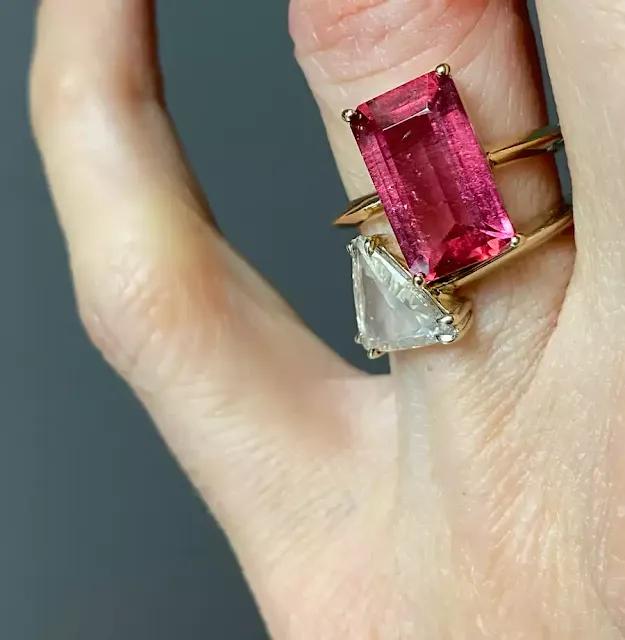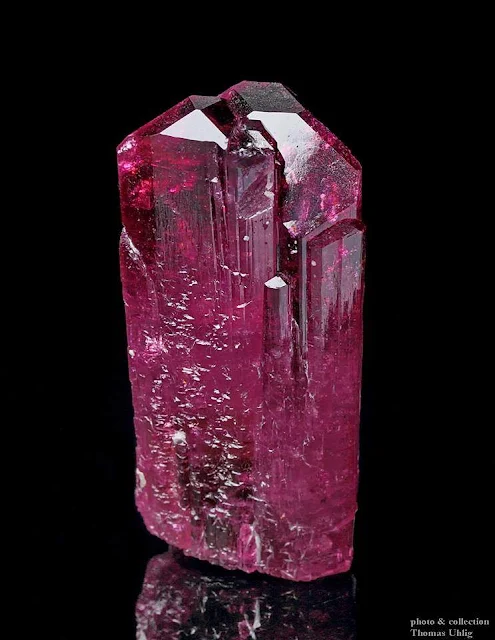Rubellite: Pink-Red Tourmaline, Properties, Value
Rubellite is the red to pink variety of elbaite tourmaline, valued for its saturated hues ranging from vivid pink to purplish-red or cranberry tones. Its coloration is primarily due to manganese (Mn) and lithium within its crystal structure.
What distinguishes true rubellite from other pink tourmalines is its color stability: it maintains a strong, vibrant red or purplish-red hue under both daylight-equivalent and incandescent lighting, without shifting toward brown or orange tones. This optical consistency, coupled with minimal undesirable pleochroic effects, gives rubellite its ruby-like brilliance.
Rubellite is found in pegmatite deposits in regions such as Brazil, Madagascar, and Afghanistan. High-quality specimens may exhibit pink-red fluorescence under ultraviolet light, and often display subtle color zoning or characteristic inclusions like growth tubes, aiding in identification. Though visually similar to ruby or spinel, rubellite can be distinguished by its trigonal crystal system, optical properties, and inclusions.
The name "rubellite" is derived from the Latin rubellus ("reddish"). It has also been historically referred to by obsolete names such as aphrite and rubelite. While metaphysical lore calls it the "Stone of Unfinished Love," its true distinction lies in its geological formation and remarkable optical qualities.
 |
| Rough vs Cut Rubellite Tourmaline. |
Coloration
The coloration of rubellite is primarily due to the presence of manganese (Mn³⁺) within the elbaite tourmaline structure. Mn³⁺ absorbs light in the green-blue range, allowing red hues to dominate. The presence of lithium supports this substitution, and the color remains stable under various lighting conditions due to the strong absorption profile and minimal interference from other elements. The intensity and stability of the color are influenced by the oxidation state of manganese, the presence of lithium, and the specific geochemical conditions during crystal growth.
Rubellite's general chemical formula is: Na(Li,Al)₃Al₆(BO₃)₃Si₆O₁₈(OH)₄, with common substitutions by Fe²⁺/Fe³⁺, Mn²⁺, Mg²⁺, and Ca²⁺.
Rubellite Physical & Optical Properties
- Luster: Vitreous to sub-vitreous (glassy to slightly greasy).
- Streak: White to light pink (diagnostic when powdered).
- Mohs Hardness: 7–7.5 (suitable for jewelry; scratch-resistant).
- Cleavage: Poor, typically indistinct in one direction.
- Fracture: Conchoidal to uneven – breaks along curved or irregular surfaces.
- Crystal System: Trigonal; commonly forms elongated hexagonal prisms, often with vertical striations.
- Specific Gravity (Density): ~3.06 g/cm³.
- Transparency: Transparent to translucent; inclusions can reduce clarity.
- Refractive Index (RI): 1.603 – 1.655 (high brilliance).
- Birefringence: ~0.018 – 0.021 (contributes to double refraction).
- Pleochroism: Strong – displays multiple shades of pink to red when viewed from different angles.
- Fluorescence: Inert (non-fluorescent under UV light).
- Adularescence: Occasionally present due to internal scattering, though not typical or diagnostic.
- Common Inclusions: Trichites – needle-like tourmaline fibers, contributing to internal shimmer or chatoyancy.
 |
| Rubellite Tourmaline crystals from Minh Tien Mine, Luc Yen, Vietnam Photo by: Riley Owen |
Distinguishing from similar gems:
Rubies: Generally have a deeper, purer red and higher hardness (9 on the Mohs scale). Rubellites may have a hint of pink or purple, and their inclusions tend to be different.
Pink sapphires: Can be similar in color, but sapphires have a different crystal structure and usually lack the inclusions common in rubellite.
Rubellite Value & Price
Determining the value of a rubellite is a multifaceted process that takes into account numerous factors beyond just its captivating beauty.
Top Factors:
- Color: Deep, saturated red dominates, pink less valuable, brown/dull tones tank value.
- Clarity: Flawless gems top the charts, inclusions hurt depending on size and visibility.
- Cut: Excellent cuts maximize beauty, poor cuts detract from value.
- Size: Bigger isn't always better, quality trumps carat weight.
- Origin: Famous mines boost value, rare finds like Paraiba skyrocket.
- Rarity: Scarce varieties command premium prices.
- Treatment: Untreated preferred, disclosure of treatment crucial.
Approximate Price Ranges (per carat)
- Pink rubellites: $100 to $500
- Red rubellites: $500 to $1,000 (for medium-quality stones)
- Exceptional red rubellites: $2,000 to $5,000 or more (for top-quality stones with intense color and clarity)
- Paraiba rubellite: $10,000 to $30,000 or more (for rare, high-quality stones)
Where is Rubellite Found
Here's a brief into where you might find this captivating gemstone:
Brazil: The undisputed king of rubellite, Brazil boasts mines like the Jonas Mine in Minas Gerais, renowned for producing vibrant, high-quality stones.
Madagascar: This island nation offers a treasure trove of rubellites, with deposits in Andranondambo and Anjanadoria yielding gems with a unique raspberry pink color.
Nigeria: Emerging as a significant source, Nigeria's pegmatites in the Oyo State produce rubellites with a deep, fiery red hue, often rivaling those from Brazil.
Mozambique: Rubellite deposits in Mozambique, particularly in the Manica and Zambezia provinces, offer a range of colors, from delicate pink to deep red, with some showcasing a desirable neon pink.
Afghanistan: This nation has a long history of rubellite mining, with deposits in Nuristan and Laghman yielding gems with a distinctive violet-pink hue.
Russia: The Transbaikal region in Siberia boasts deposits of rubellite, known for their exceptional clarity and transparency.
 |
| Rubellite Tourmaline from Pala District, San Diego County, California |
Rubellite Uses
Jewelry: Undoubtedly the most popular use for rubellite, its stunning pink and red hues make it a mesmerizing centerpiece in rings, necklaces, earrings, and bracelets.
 |
| Rubellite Tourmaline Ring - Vivid Pink-Red Gemstone in Gold Setting. |
Collector's Items: Rare and exceptional rubellites, boasting exceptional clarity, intense color, and large size, become prized possessions for collectors and connoisseurs.
Carvings and Sculptures: Rubellite's beauty extends beyond facets and cuts. Larger rough stones can be carved into intricate sculptures, figurines, and decorative objects.
 |
| Rubellite Tourmaline From Malkhan pegmatite field, Krasnyi Chikoy, Zabaykalsky Krai, Russia Photo: proper_gems |
Metaphysical and Healing Properties:
While not scientifically proven, some believe rubellite possesses metaphysical and healing properties. It's associated with love, passion, creativity, and emotional well-being. Some wear it to promote self-confidence, balance emotions, and attract positive energy.
 |
| Museum-Quality Rubellite Crystal - Rare Natural Red Tourmaline with Prismatic Form and Perfect Termination. Photo: Thomas Uhlig |
Read also:
Tourmaline: The Colors and Varieties of Tourmaline
Paraiba Tourmaline - Properties, Value, Occurrence and Uses








